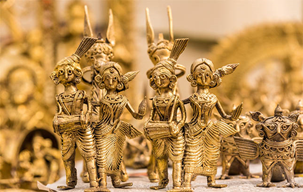

Context
Lalbazar, on the boundary with Jharkhand, is becoming a hub for dokra metal craft, in West Bengal.
About
About the Dokra metal craft:
- Background: It is an ancient tradition whose documented history is about 5,000 years old.
- There are many processes involved, for which seven to eight varieties of clay is required, apart from other raw material.
- Making dokraart is a difficult process. Each figurine takes about a month to make.
- Key features:
- Dokra (also spelt Dhokra)is non–ferrous metal casting using the lost-wax casting technique.
- This sort of metal castinghas been used in India for over 4,000 years and is still used. One of the earliest known lost wax artefacts is the dancing girl of Mohenjo-daro.
- The lost wax technique for casting of copper based alloyshas also been found in China, Egypt, Malaysia, Nigeria, Central America, and other places.
- Dhokra Damar tribes are the main traditional metal smiths of West Bengal and Odisha. Their technique of lost wax casting is named after their tribe, hence Dhokra metal casting.

|
Recently Adilabad Dokra from Telangana got Geographical Indication tag in 2018. |
Dhokra Damar Tribes:
- The tribe extends from Jharkhand to West Bengal and Odisha; members are distant cousins of the Chhattisgarh Dhokras.
- A few hundred years ago, the Dhokras of Central and Eastern India travelled south as far as Kerala and north as far as Rajasthan and hence are now found all over India.
- Dhokra, or Dokra, a craft from Dwariapur, West Bengal, is popular.
Process of lost wax casting-
- There are two main processes of lost wax casting: solid casting and hollow casting.
- While the solid casting is predominant in the south of India the latter is more common in Central and Eastern India.
- Solid casting does not use a clay core but instead a solid piece of wax to create the mould; hollow casting is the more traditional method and uses the clay core.
- The first task in the lost wax hollow casting process consists of developing a clay core which is roughly the shape of the final cast image.
- Next, the clay core is covered by a layer of wax composed of pure beeswax, resin from the tree Damara orientalis (more properly Agathis Damara), and nut oil.
- The wax is then shaped and carved in all its finer details of design and decorations. It is then covered with layers of clay, which takes the negative form of the wax on the inside, thus becoming a mould for the metal that will be poured inside it.
- Drain ducts are left for the wax, which melts away when the clay is cooked. The wax is then replaced by the molten metal, often using brass scrap as basic raw material.
- The liquid metal poured in hardens between the core and the inner surface of the mould. The metal fills the mould and takes the same shape as the wax.
- The outer layer of clay is then chipped off and the metal icon is polished and finished as desired.

